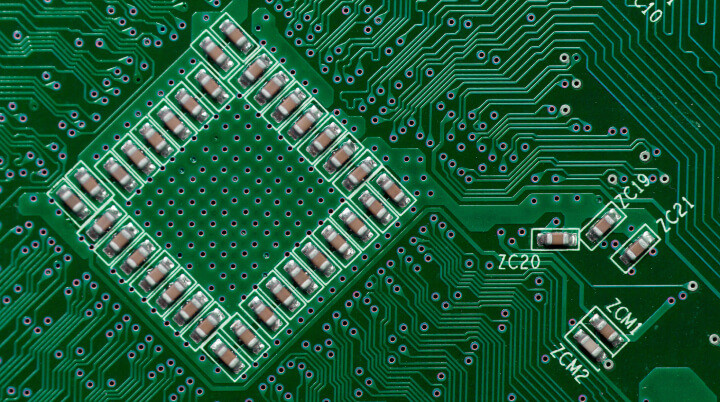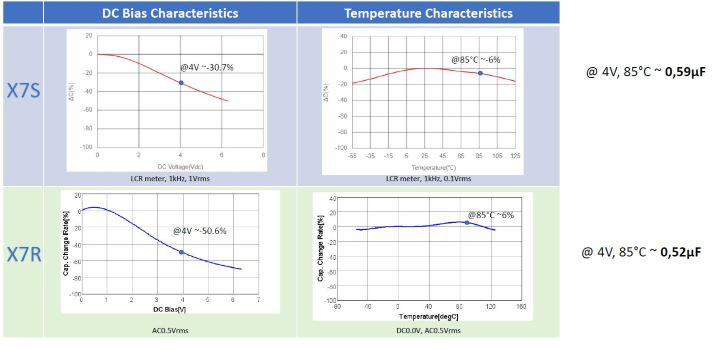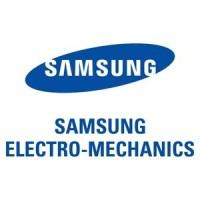X7R vs. X7S MLCCs: A Comprehensive Guide for Engineers
Insights | 09-11-2023 | By Samsung Electro-Mechanics

Key Things to Know:
- X7R vs. X7S MLCCs: The article discusses the differences between X7R and X7S multi-layer ceramic capacitors (MLCCs), focusing on their temperature coefficient of capacitance (TCC) and DC bias performance. X7R is widely used due to its ±15% tolerance over a -55°C to +125°C range, but X7S can offer advantages in certain applications.
- Importance of DC Bias in MLCC Selection: It emphasizes the significance of considering not only TCC but also DC bias when selecting MLCCs for automotive and industrial electronics, as DC bias can significantly affect capacitance.
- SEMCO's MLCC Solutions: Samsung Electro-Mechanics Co (SEMCO) is highlighted for its focus on providing MLCCs that perform strongly in both TCC and DC bias parameters, with some X7S MLCCs outperforming X7R counterparts under specific conditions.
- Market Awareness and Future Developments: The article addresses the lack of market awareness about the benefits of X7S MLCCs and encourages engineers to consider all options for high-capacitance requirements, pointing to ongoing developments in MLCC design and materials.
In the landscape of electronic component design, the selection of multi-layer ceramic capacitors (MLCCs) is crucial for the development of automotive and industrial electronics. The industry's preference for specific types of MLCCs, such as X7R and X7S, often hinges on their temperature coefficient of capacitance (TCC) and DC bias performance. This article delves into the nuances of these components, highlighting the importance of a comprehensive evaluation that includes both TCC and DC bias. By examining the strengths and potential advantages of X7S MLCCs over their X7R counterparts, we aim to shed light on considerations that could significantly impact the efficiency and reliability of electronic circuits.
Understanding X7R and X7S MLCCs: A Comparative Overview
The most common MLCCs (multi-layer ceramic capacitors) in the industrial and automotive markets come with a TCC (temperature co-efficient of capacitance) known widely as X7R, where the ‘X’ stands for -55°C, the ‘7’ for +125°C and the ‘R’ for ±15% tolerance over this temperature range.

With its narrower capacitance-change tolerance band of ±15%, many design engineers will simply select the X7R product over X7S. However, when choosing an MLCC, it is important to consider not only TCC, but also DC-bias, namely the capacitance change at the applied DC voltage. Samsung Electro-Mechanics Co (SEMCO) focuses on MLCC solutions that provide strong performance in both TCC and DC-bias parameters. And while some X7R products offer better DC-bias than X7S, the opposite is also true, with certain X7S MLCCs providing a distinct advantage.
So how come more companies are not specifying X7S MLCCs? The answer, it appears, is nothing more than a lack of awareness.
In modern automotive and industrial electronics, higher integration and increasing functionality are common trends, both of which tend to demand more and more capacitance. Here, an MLCC offering a TCC with X7S characteristics possibly provides higher effective capacitance than an MLCC that has a TCC with X7R attributes (at the same nominal capacitance rating), because TCC is just one factor that affects capacitance. Another major influencer is DC bias.
DC bias is the change in capacitance when a DC voltage is applied across the terminals. MLCCs need to deal with DC voltage biasing and are therefore also susceptible to this phenomenon. The capacitance value will drop as DC voltage rises, which can negatively affect many types of circuit.
The Development Challenge
There are a number of ways that OEMs can develop MLCCs with higher capacitance values, most of which typically involve improvements in ceramic materials. For example, a smaller grain size allows thinner layers, while additional grain treatment can improve homogeneity and reliability. In addition, improved material doping can increase the relative dielectric constant (εr). All of these factors can lead to higher capacitance values, with notable results that include 10µF/50V in 1206 package size. Any design engineers seeking a high-density, high-efficiency solution in a compact case size can benefit from this MLCC. Applications that demand high electrical precision, stability and reliability will see gains, including power supply bypass circuits, consumer electronics and telecommunications equipment.
To delve deeper, relative dielectric constant (sometimes known as relative permittivity) is a measure of the amount of electric potential energy, in the form of induced polarization, stored in a given volume of material under the action of an electric field. However, when increasing the relative permittivity of a ceramic material, there is a particular side effect: users can expect to witness a higher change of relative permittivity with varying operating conditions, namely applied DC voltage, TCC and time. Put simply, delivering capacitance stability depends on achieving a good balance of MLCC properties that can derive the best performance from these usage conditions.
Capacitance Loss
All Class II MLCC formulations (including X7R and X7S) vary in capacitance value according to applied DC voltage (DC bias), TCC and time (aging). The latter, for instance, occurs as ceramic grains lose the ability to re-orientate over time, largely due to the need of domains to find energetically more stable states. This domain stabilization leads to a decrease in relative permittivity, which translates directly into a loss of capacitance.
Of course, most design engineers already know that DC bias significantly decreases the effective capacitance of Class II MLCCs. Just to clarify, both X7S and X7R formulations are ‘temperature-stable’ ceramics that fall into EIA Class II materials. Along with TCC and aging, these three factors depend on each other, whereby improving one will have an impact on one or both other factors. The broad consensus is that enhancing both TCC and DC bias simultaneously will only result when there is a future improvement in the overall ceramic powder system.
X7S: Better DC Bias
There is good news, however, as SEMCO reveals that its current X7S MLCCs can possibly offer better DC bias than X7R counterparts. To demonstrate, the company ran a series of measurements setting out the DC bias performance characteristics of a SEMCO X7S MLCC and an X7R device from another manufacturer. In terms of specification, both were 1µF 10% 6.3V MLCCs in 0402 package/case size.
The measurements revealed that the SEMCO X7S MLCC showed a capacitance change rate of approximately -30.7% at 4V. In comparison, the other suppliers X7R MLCC demonstrated a notably more sizable capacitance change rate of around -50.6% at 4V. As already stated, there is some impact on TCC due to this improvement in DC bias. At 4V and 85°C, the SEMCO X7S MLCC saw a -6% capacitance change rate, compared with +6% (at 4V, 85°C) for the MLCC from the other manufacturer.

As the graph shows, the SEMCO X7S 1µF MLCC remains the better overall performer, still delivering capacitance of 0.59µF at 4V, 85°C, compared with just 0.52µF for the X7R.
Low Market Awareness
The market is very familiar with the X7R tolerance band of ±15%, making it difficult to displace as the preferred technology without a deep dive into MLCC specifics. However, as the aforementioned measurements showed, when real working conditions are taken into account – comparing TCC and DC bias – the X7S MLCC could demonstrate higher remaining capacitance.
The factors explored in this article are often true for high capacitance values, where the DC bias is increasingly visible and working to reduce the effective capacitance. This is also where design engineers often fight for every additional nF with tight calculated margins.
Moving Forward
Any electronic or electronic component engineers involved in the automotive, industrial or other markets, will gain rewards from taking a closer look at X7S for their high-capacitance MLCC requirements. The results set out by SEMCO demonstrate that X7S MLCCs can sometimes offer a notably better DC bias than like-for-like X7R counterparts. Even when taking TCC into consideration, X7S MLCCs often show themselves as the best overall performers.
There are many ongoing developments in MLCC design as suppliers look to meet the increasingly high demands of engineers in the modern electronics industry. Research into new materials and the effects of parameters such as TCC and DC bias mean that correct MLCC selection hinges very much on the specific application. X7R and X7S MLCCs can provide the optimal solution depending on the project’s objectives. For designers wishing to avoid handing the advantage to competitors, the overriding message is do not simply continue with historical MLCC choices for new projects, but consider all options. The gains available might provide a rewarding surprise.
To learn more about Samsung Electro-Mechanics range of MLCC products please visit: https://www.samsungsem.com/global/product/passive-component/mlcc.do
This article was written by Benjamin Blume, Team Leader Application Engineering Europe and Hank Kang, Product Manager Passive Components
About the Authors:
Benjamin Blume: As the Team Leader for Application Engineering in Europe at Samsung Electro-Mechanics, Benjamin Blume is a pivotal figure in the field of electronic components. His expertise in electrical engineering drives innovative projects, solidifying his reputation as a leader in technical advancements.
Hank Kang: Product Manager for Passive Components at Samsung Electro-Mechanical, Hank Kang is renowned for his insights into market trends and technological developments in electronics. His focus on passive component management positions him as a key influencer in the industry.

